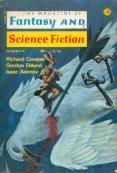Some of the short, speculative fiction of 1976:
The Bicentennial Man, by Isaac Asimov, which won the Hugo Award (1977) and the Nebula Award for best novelette
Houston, Houston, Do You Read? by James Tiptree, Jr. which won the Nebula Award and the Hugo Award (tie, 1977) for best novella
Russell Kirk’s There’s a Long, Long Trail A-Winding, which won the World Fantasy Award for best short story (1977)
By Any Other Name,by Spider Robinson, which won the Hugo Award for best novella (tie, 1977)
Piper at the Gates of Dawn , by Richard Cowper
, by Richard Cowper
The Diary of the Rose, by Ursula K. Le Guin
Gotta Sing, Gotta Dance, by John Varley
Tricentennial,by Joe Haldeman, the Hugo winner for best short story
A Crowd of Shadows, by Charles L. Grant, the best short story Nebula winner
.
Some of the movies of 1976:
Carrie, based on the 1974 Stephen King novel about a misfit teenage girl with telekinesis powers.
 Logan’s Run , based on the novel by William F. Nolan and George Clayton Johnson. The novel portrays a dystopia in which humans are put to death at the age of twenty-one, whereas the movie is set in a post apocalyptic society and humans are put to death at the age of thirty. Some attempt to escape their fate, hence the title.
Logan’s Run , based on the novel by William F. Nolan and George Clayton Johnson. The novel portrays a dystopia in which humans are put to death at the age of twenty-one, whereas the movie is set in a post apocalyptic society and humans are put to death at the age of thirty. Some attempt to escape their fate, hence the title.
The Man Who Fell to Earth, adapted from Walter Tevis’ 1963 novel. The movie’s protagonist, played by David Bowie, is an extraterrestrial being in search of a way to transport water to his planet, which is suffering severe droughts as a result of violent wars.
.
Some of the notable novels of 1976:
Shadrach in the Furnace by Robert Silverberg. I haven’t read this novel, but it sounds interesting. The novel is set in 2012, in Mongolia. Shadrach Mortecai is the personal physician to Genghis II Mao IV, the world dictator, who is attempting to achieve immortality through three significant Projects; Phoenix, Talos, and Avatar. Project Talos would involve an automated Genghis Mao and Project Phoenix would require a relentless challenge of brain regeneration. Project Avatar offers the greatest chance of success; it would transfer Genghis Mao’s personality into a younger body. Genghis Mao’s son, Mangu, who is admired by all who meet him, is selected as the subject of Project Avatar.
Brontomek, by Michael Coney, which won the BSFA. Not only haven’t I read Brontomek!, I hadn’t heard of it before. The author passed away in 2005, a victim of asbestos-induced lung cancer. There is very little information about the book on the internet, but I found the following description at Amazon: The planet Arcadia was on the verge of economic collapse. Its human colony had been decimated by the strange Relay Effect; in the aftermath, still more colonists were leaving for other worlds. The Hetherington Organisation promised to change that. If the remaining colonists put themselves entirely in their hands for a five-year period, they would transform Arcadia into the most prosperous planet settled by mankind, while preserving its great natural beauty. It was an offer the Arcadians could not possibly refuse, for the alternative, after all, was an accelerating slide into poverty and, eventually, savagery. Only when the Hetherington Organisation’s first cargo ships arrived, unloading a huge stream of brontomeks – huge robot agricultural machines, heavily armoured – and an army of amorphs, aliens who were capable of moulding themselves into human form, did the colony begin to realise what it had committed itself to. Brontomek! is a sequel to two earlier books, Syzygy and Mirror Image. Like its predecessors it is an ingenious, adventurous tale of the type which has rapidly made Coney one of SF’s foremost entertainers
Where Late the Sweet Birds Sang, by Kate Wilhelm, which won the Hugo Award and the Locus Award. The lovely title is a quotation from Shakespeare’s Sonnet LXXIII, a muse regarding aging. It could be remarked (in a fit of snobbery) that the title is the best part of the novel, but that would be unfair; the novel has a wonderful heart and contains some vibrant descriptive prose, although I did find some of the writing awkward. The novel imagines a post-apocalyptic future in which the surviving humans — the Sumner family — use cloning as the only alternative to continue the future of several species. Pollution, famine, war, overpopulation, and a virulentvirus have combined to cause sterility in humanity along with many other species. The cloned humans mature into an unfamiliar species, fundamentally different from their ancestors. The communal psyche that develops is contrasted with the spontaneity and adaptability of an ‘unusual’ character, Mark, who was born the old-fashioned way and was raised apart from the clone-culture until the age of five. He is the messenger of a central theme; evolution is a necessary constituent of biological life.
Man Plus, by Frederick Pohl, which won the Nebula Award. I started this book, but wasn’t drawn in; the writing felt stilted and skewed too far  toward the soap opera for my tastes (a definite ‘genre’ novel). I will try it again someday because it is a classic science fiction novel, but for now I can only offer the book’s description: “…a desperate war for natural resources threatens to bring civilization to a crashing halt. Nuclear warships from around the globe begin positioning themselves as the American government works feverishly to complete a massive project to colonize Mars. Former astronaut Roger Torraway has agreed to be transformed by the latest advances in biological and cybernetic science into something new, a being that can survive the rigors of Mars before it is terraformed. Becoming Man Plus will allow him to be the linchpin in opening the new Martian frontier…but not without challenging his humanity as no man has ever been challenged before.”
toward the soap opera for my tastes (a definite ‘genre’ novel). I will try it again someday because it is a classic science fiction novel, but for now I can only offer the book’s description: “…a desperate war for natural resources threatens to bring civilization to a crashing halt. Nuclear warships from around the globe begin positioning themselves as the American government works feverishly to complete a massive project to colonize Mars. Former astronaut Roger Torraway has agreed to be transformed by the latest advances in biological and cybernetic science into something new, a being that can survive the rigors of Mars before it is terraformed. Becoming Man Plus will allow him to be the linchpin in opening the new Martian frontier…but not without challenging his humanity as no man has ever been challenged before.”
Doctor Rat, by William Kotzwinkle, which won the World fantasy Award. The novel has the sensibilities of a manifesto calling for social awareness; it is a depiction of humanity’s lack of compassion — cruelty — toward other species (in this case, experiments on rats); and, by extension, other humans. The protagonist, Dr. Rat, has run the maze too many times and he is quite insane. Dr. Rat describes a gruesome life within an experimentation laboratory, which is wretchedly similar to a concentration camp. The book paints a sinister picture of psychiatric research using animals; and, by extension, the often inhumane methodology of dealing with mankind’s mental illnesses. There are moments of humour, but the novel is often frightening and appalling. In the chilling words of Dr. Rat: “Death is freedom!”
Triton, by Samuel R. Delany. The novel has since been published as Trouble on Triton: An Ambiguous Heterotopia, and is loosely connected to Delany’s Neveryóna series through the modular calculus, an abstract mathematical system that can purportedly be used to evaluate fictional construct theory (and perhaps the personality of the person reading the book?). The protagonist, Bron Helstrom, has moved from Mars to Triton. On Mars, he was a male prostitute; although life on Triton is much easier, Bron is still unhappy. He is an unusual protagonist; self-centered and quite unlikable, socially inept and quite skillful at finding others to blame as the source of his ennui. It is intriguing to note that Bron lived in a city called Bellona on Mars; Bellona is the setting in Delany’s Dhalgren, which supposedly takes place on Earth. Triton has some similarities to Delany’s Stars in My Pocket, Like Grains of Sand (Stars), but Stars has a superior structural integrity and a more likeable protagonist. I enjoyed Triton, but it felt slightly clunky compared to Delany’s more finely crafted works (Dhalgren, the Neveryóna series, and Stars in My Pocket, Like Grains of Sand).
And my choice as Retrospecualtive novel of 1976 is…
The Alteration, by Kingsley Amis, which won the John W. Campbell Memorial Award (1977). The Alteration is an alternate history/parallel universe novel in which the Protestant Reformation did not occur and Martin Luther became Pope Germanian I. An important alteration within the novel involves ten-year-old Hubert Anvil, a choir member with an exquisite voice. The Church decides that the boy must not lose the precious gift; therefore, he must be castrated. Sexuality is a significant subject in the book, and the concept of  art performed by a castrato, and the celibacy of Catholic priests, are central concepts.
art performed by a castrato, and the celibacy of Catholic priests, are central concepts.
In the novel, the word science is an obscenity — heresy — and inventions are rare: electricity is prohibited. The Roman Catholic Church’s rule in Western Europe is administered by the Holy Office, an oppressive regime. Women are definitely secondary citizens.
It is an excellent alternate history novel, ranking (IMHO) with PK Dick’s The Man in the High Castle, which is referred to in The Alteration as an alternate history novel (similar to the alternate history novel within PK Dick’s book, The Grasshopper Lies Heavy. It is interesting to note that the PK Dick novel within Amis’ novel is different from the one that exists in our reality). Keith Robert’s Pavane, another excellent alternate history novel (which also dealt with Catholic despotism), is also mentioned, but renamed Galliard, after another European Renaissance dance.
The Alteration is very well-written, but it is a bit ‘over-starched’ in some sections, almost like a textbook; nevertheless, Amis obviously loves music, and his sojourns into melodic descriptions are delicate arias, allowing the reader to relax between the pedantic sections of the book. Amis also sprinkles the book with humour, thereby softening his academic portrayal of a dystopic society.
To fully understand the novel, it helps to have a solid knowledge of the Renaissance period; my education is woefully deficient, so I needed to peruse the web for background information. The Alteration is an enjoyable, intellectual book; my only quibble is a wish that he had ‘let loose’ a bit more; it would have made for an even more exceptional book.
.
.
.
